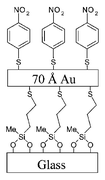A robust ultrathin, transparent gold electrode tailored for hole injection into organic light-emitting diodes
Abstract
A viable alternative to the problematic indium tin oxide (ITO) glass substrates invariably employed as the anode in organic light-emitting diodes is reported; namely ultrathin gold electrodes supported on glass. The key element to the successful fabrication of these electrodes is the pre-treatment of the glass substrate with the adhesion promoter


 Please wait while we load your content...
Please wait while we load your content...